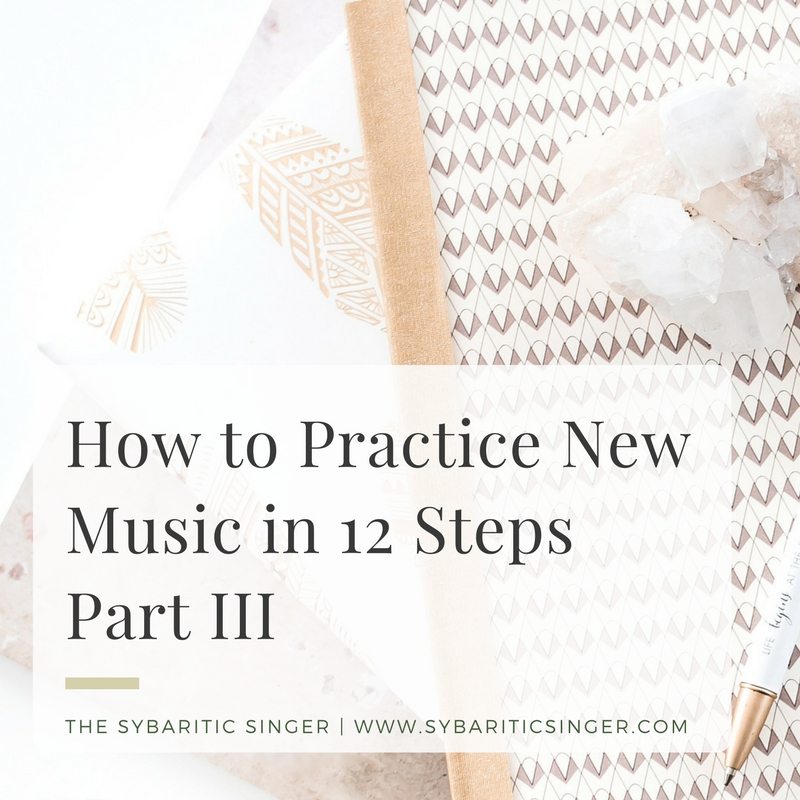Every musician has to practice to refine their skills. Their motivational techniques behind their practice, the steps that they follow during practice, and how they think and feel about practicing are all unique to that person. However, I’ve been trying to put together my own practice plan for myself and for my students. These are those checklist items that can help get me into “flow state,” as Mihaly Csikszentmihalyi might say, faster than anything else.
Getting into the flow is one of the ways that I’ve found that heightens my personal experience with practicing. Being “in the zone” takes practicing from being “a slog” or “drudgery” and turns it into the fullest expression of living. I am alive. Look at, and listen to, this incredibly unique thing that my body can do!
Let’s continue with our steps…

How to Practice New Music in 12 Steps – Part III
9. Diction
It is necessary that the articulations and pronunciations we use as singers are fitting a suitable for the text, the music, and the occasion. It is important to identify the vowels and consonants in the musical line that are falling back into our non-helpful repetitive personal speech habits and those that are useful for the concert hall or opera stage. Using dialects and colloquialisms can be common in all types of music. It’s important to do your research on the character, the poet, the style, and the composer to make sure that your diction serves the music. Many common problems with inflexibility in the articulators can fade away when you begin to drill the full range of movement – particularly in areas that have been challenging for you in the past.
As Joan Wall suggests, “Diction is the playground of the vocal line, so, phrase after phrase, you will apply thousands of distinctions that ultimately shape the sounds, expressions, and intelligibility of your singing.” This reminds me of seeing Steven Schick at New Music Gathering 2017. In his keynote speech (I highly encourage you to watch it. It was so inspiring.), he said, “At age 19, an existence founded on finding the perfect tam-tam stroke or a silky smooth snare drum roll was thinkable. At age 63, it is not.” The focus on finding “the perfect tam-tam stroke” is similar to the enjoyment of executing the expressiveness of German consonants or the ultimate legato nature of liaison and elision in French.
10. Translate & Transliterate
I get those translations and transliterations into my scores as quickly as possible. Knowing the meaning of the text as well as the specific pronunciation of the text is absolutely necessary. In the grand scheme of this list, speaking the text in rhythm was listed under point #5 but that can’t happen until I’ve done this step. I need to know where the syllabic emphasis of the line happens in both the spoken version of the text and how the composer’s prosody either aligns with that or actively contradicts. I also need to know the meaning of each phrase and get a sense for the poetic intent.
When I really think about the creative power that comes along with sung words, I am instantly humbled. There is a deep well of joy that comes along with the expressive capability to sing text. It might be my favorite part of what I do.
11. Score study with recordings
As a specialist in contemporary classical music, not every one of my scores comes with a long history (or even a short history) of recordings. If I’m working on something that does have a history of recordings, I schedule practice time to listen to them. There is a reason that this is #11 on the practice plan. I don’t want to become too influenced by recordings. However, I spent too much time being afraid to listen to other recordings because of mentors and peers who shamed me for using them. Recordings can be a crutch but they are more likely to be a resource and an asset. Make sure that you’re using them as the latter. If you’re working with a score that doesn’t have any recordings, there is no shame in asking for a midi recording if it’s available. I have definitely spent various car rides internalizing certain pieces through midi realizations to maximize my practice efforts. Also, do some research for other recordings of that composer’s works (the best are the recordings that the composer oversaw themselves) or conductors who have worked with/studied with the composer.
12. Create Nuances
Performing it incorrectly is not the same thing as creating nuance. It is even worse if you do not know that you’re not performing it correctly. Working up the repertoire to a level of musical excellence, however, and then finessing your performance to reflect your musical goals, aesthetic, and personal voice brings it to the level of 100% ability.
Technical skills are eventually integrated into an artistic and kinesthetic whole. Remaining only analytical about the what, how, and when of singing, sacrifices the why. You simply cannot achieve 100% ability without the why. Practicing can be the daily effort that helps you to keep having paying job after paying job. But, a singing discipline without the why is still an impoverished way to live the dream.
The List Goes On
A singing practice is a practice. As they remind us in yoga, “Come back to your mat.” It is a discipline that stays with us throughout our lifetime. This is my go-to list that helps me get in “flow state.” But, I add to this list with each practice session. One of the additions I like is to say a word of thanks — thank your composers, collaborators, mastermind group, family members, and anyone that helps you get into your practice room everyday.
What else is on your list? I’d love to know. You can tell me all about it in the comments below, on our Facebook page, or on Twitter!
